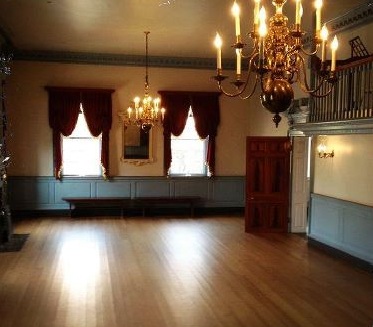The attitude toward dance among the colonies varied. Philip Fithian, a young Presbyterian student from Princeton hired as a tutor by Virginia’s Robert “King” Carter, quickly discovered that, unlike people in New Jersey, Virginians loved to dance. Dancing masters would travel from plantation to plantation, teaching the children posture, manner and deportment as well as the latest dances. As Lord Chesterfield wrote to his illegitimate son, “If a man walks well, presents himself well in company, wears his hat well, moves his head properly, and his arms gracefully, it is almost all that is necessary,” and the best way to learn it was to study dance.
A ball would typically begin with minuets, danced by one partner at a time. Slow and elegant dances, with an emphasis on intensity and form, minuets were the “tango” of the 18th century. (Click Minuets here for more.) The minuets would likely be followed by the “English country dances,” danced in long lines with partners facing each other, as in this example. Other common types of dances were French cotillions, an early form of “square dance,” and also hornpipes, jigs, and reels.
Selected Bibliography and Resources for 18th Century Dance in America
Kate van Winkle Keller and Charles Cyril Hendrickson have published numerous excellent “how to” books and histories, e.g.
Dance and Its Music in America, 1528-1789
The Playford Ball, 2nd Ed.
No Kissing Allowed in School!
The Richmond Assemblies 1790-1797
A Colonial Dancing Experience
John Griffiths, Dancing Master
Social Dances from the American Revolution
Another noted expert, with emphasis on the more refined and stylized aspect of 18th century dance, is Wendy Hilton —
Dance and Music of Court and Theater (Preview can be found on Google eBooks)
Playford’s The English Dancing Master is now available online. And here’s another version with the music!
For an explanation of the different steps, here are some websites:
Videos of people actually dancing particular dances can sometimes be found on Youtube. Here’s Childgrove for example.
An excellent resource for English Country Dance is the Country Dance and Song Society
A detailed overview of Baroque, late 18th century, and regency dance as well as original dance instruction manuals are available at the Library of Congress website.